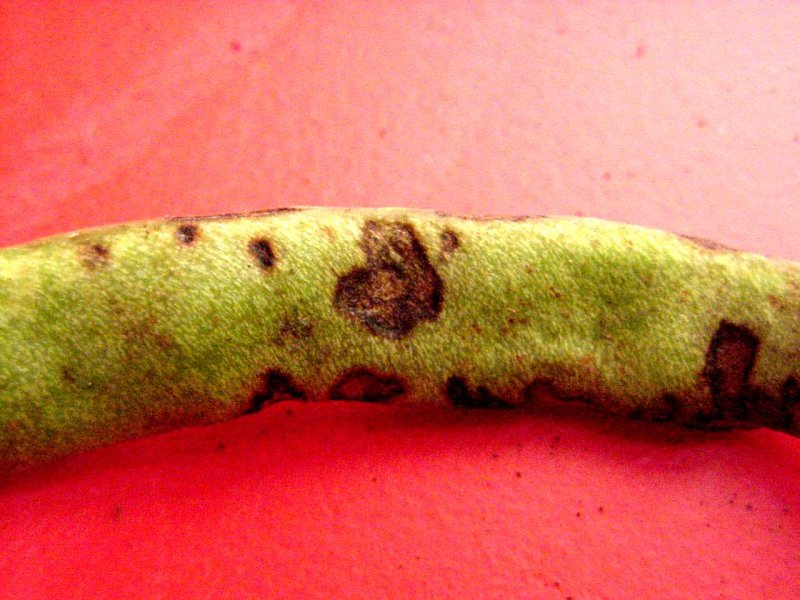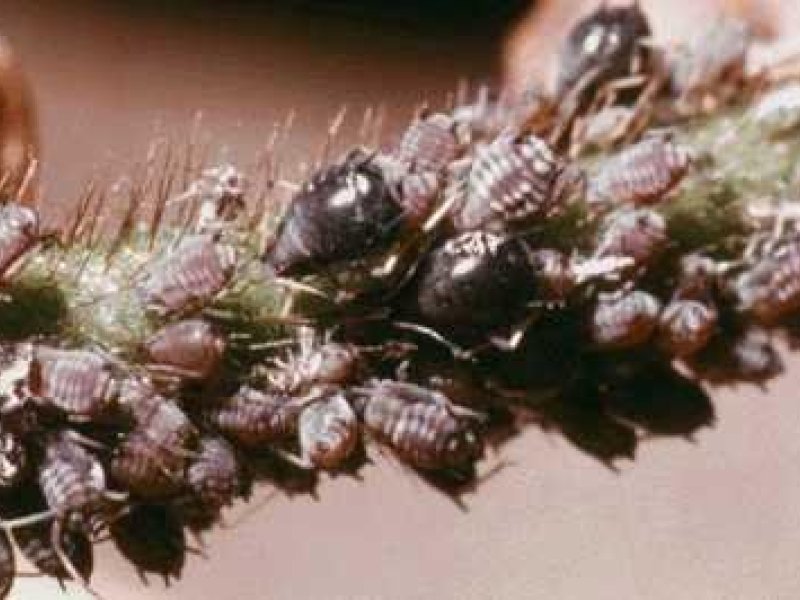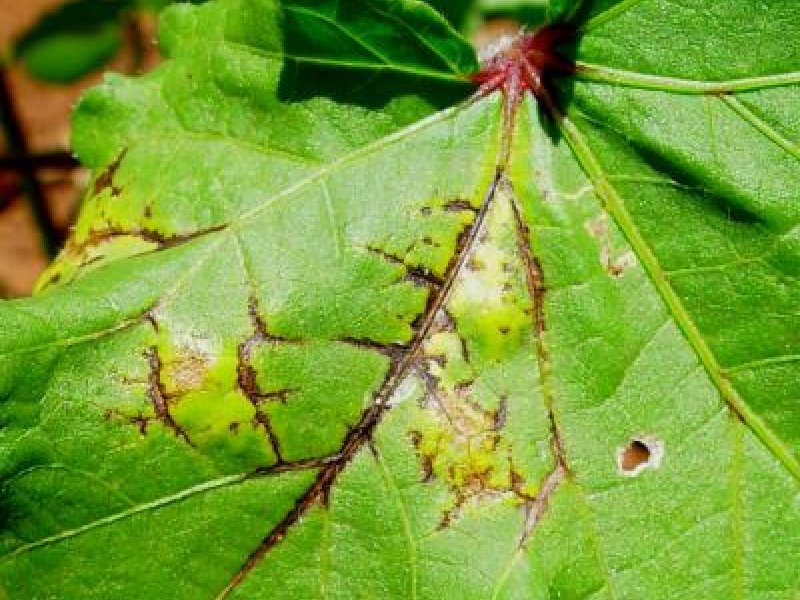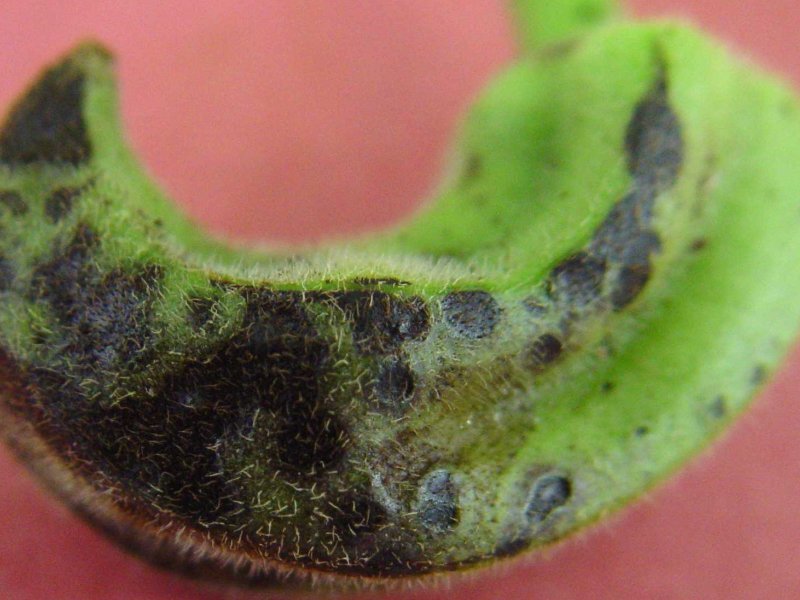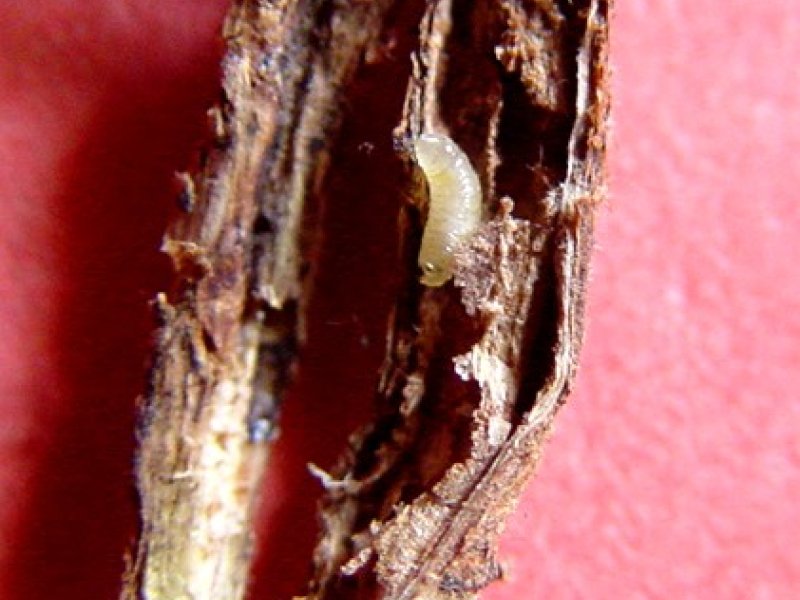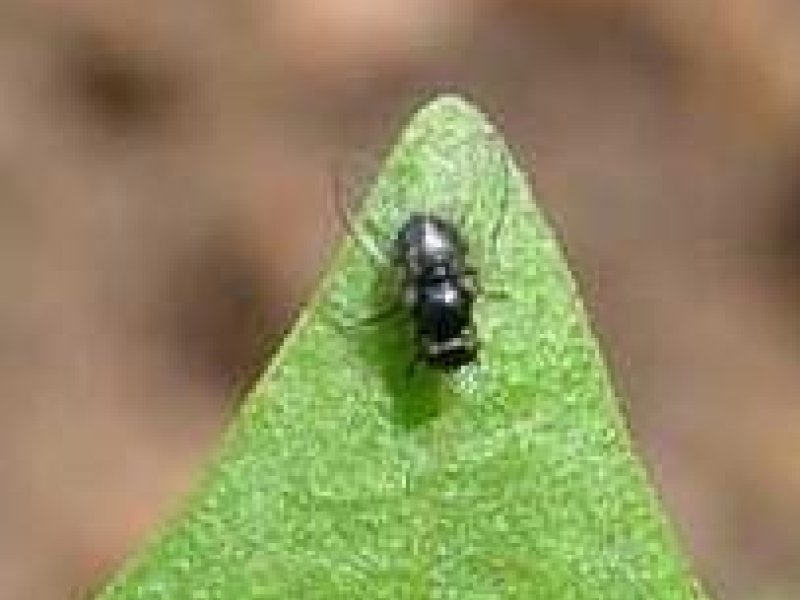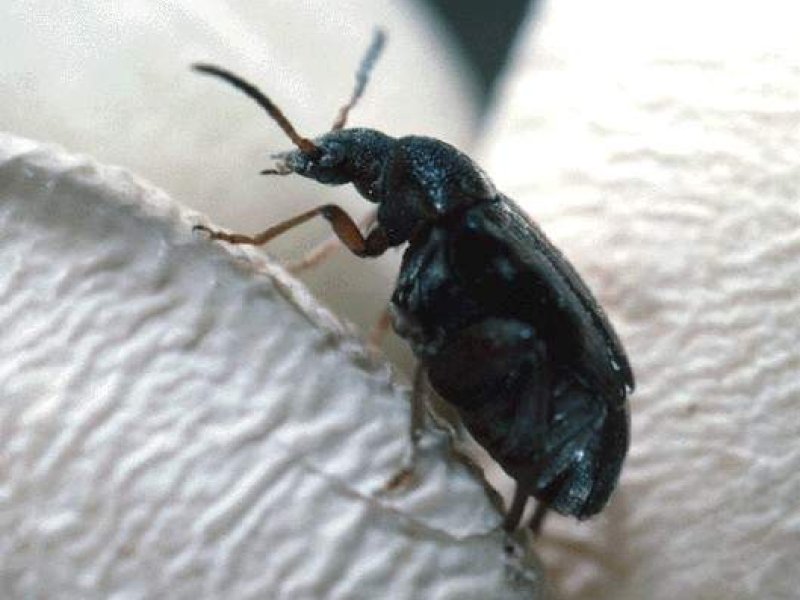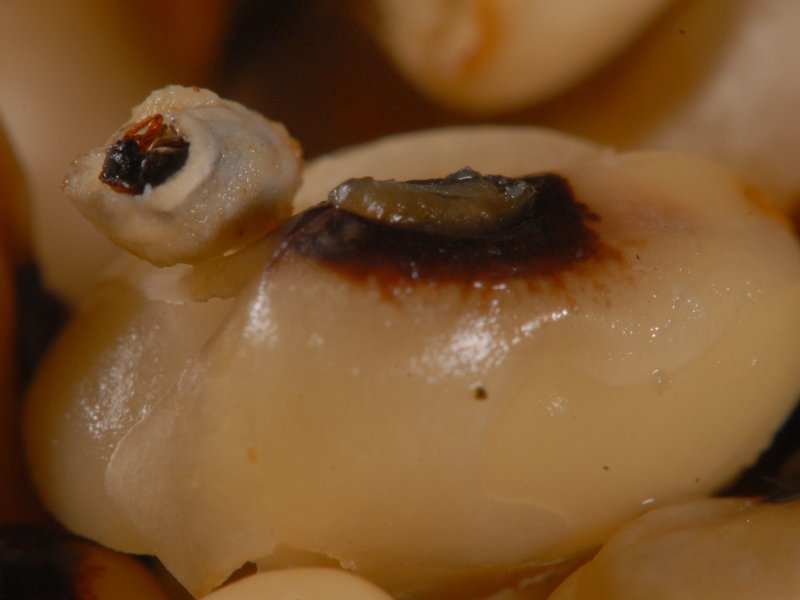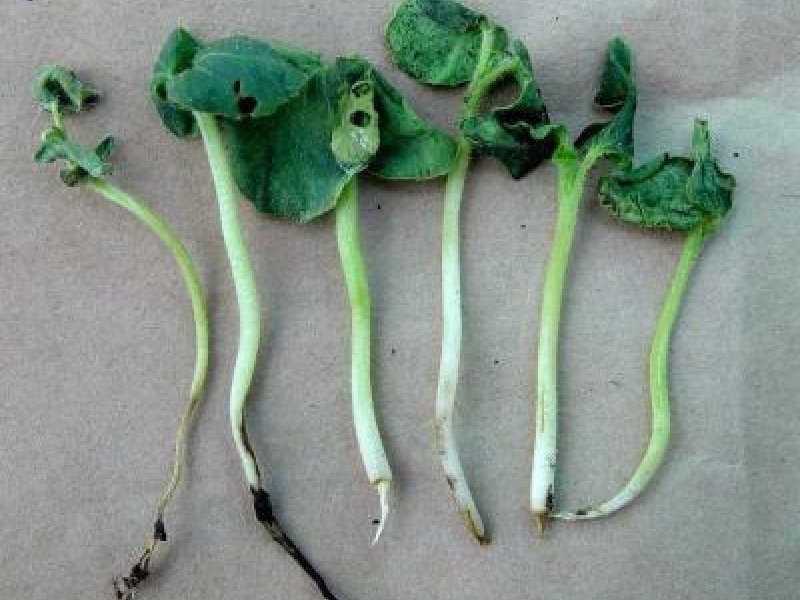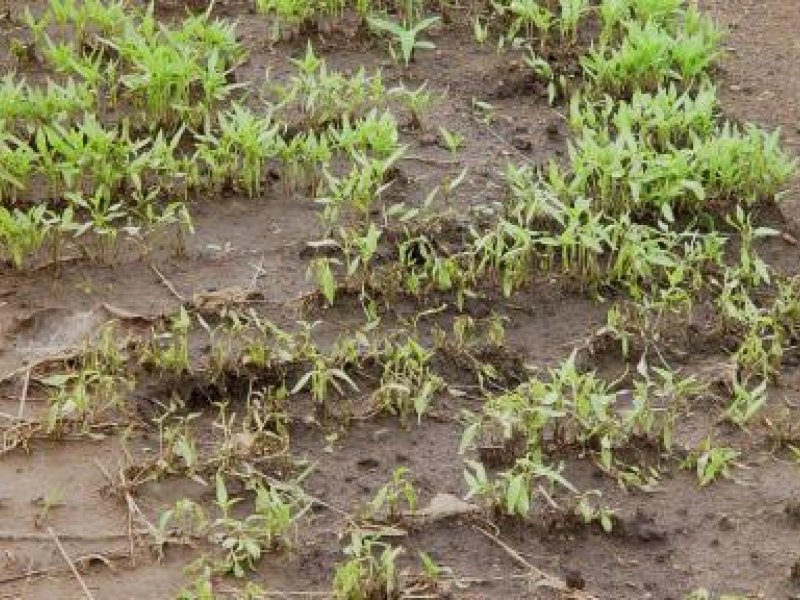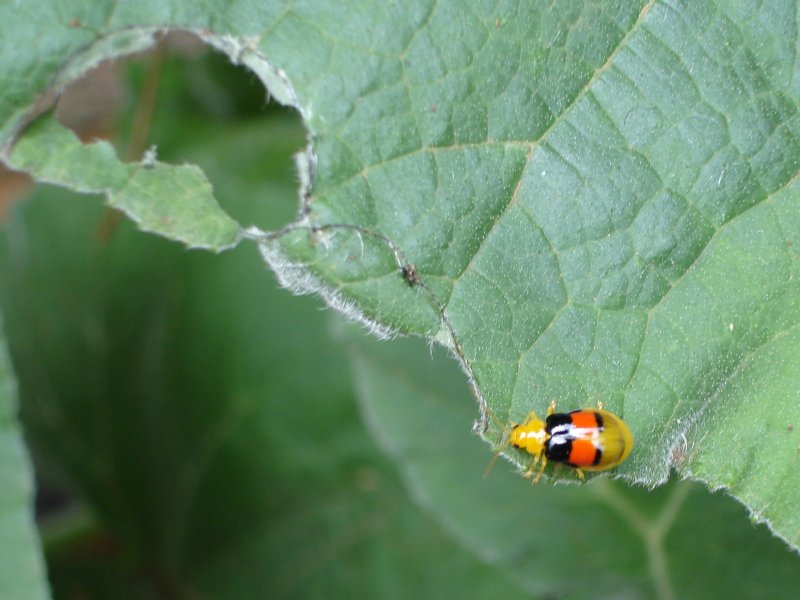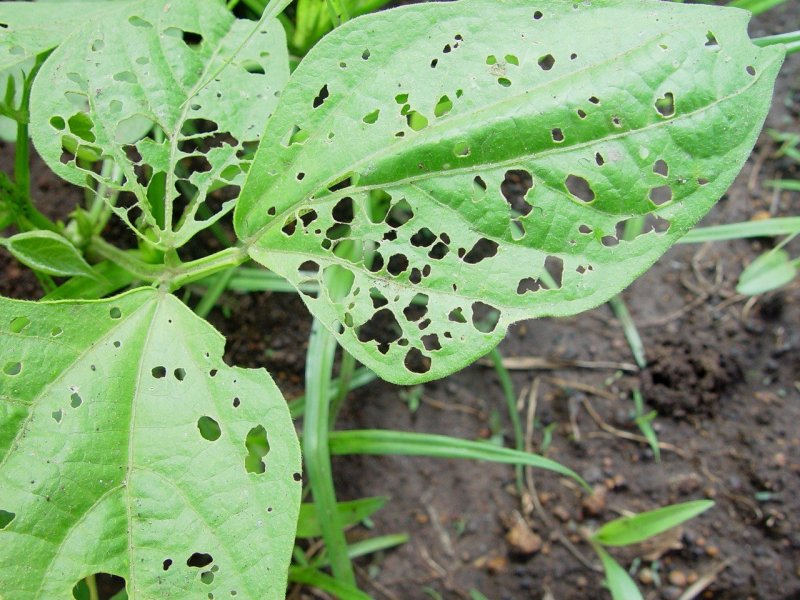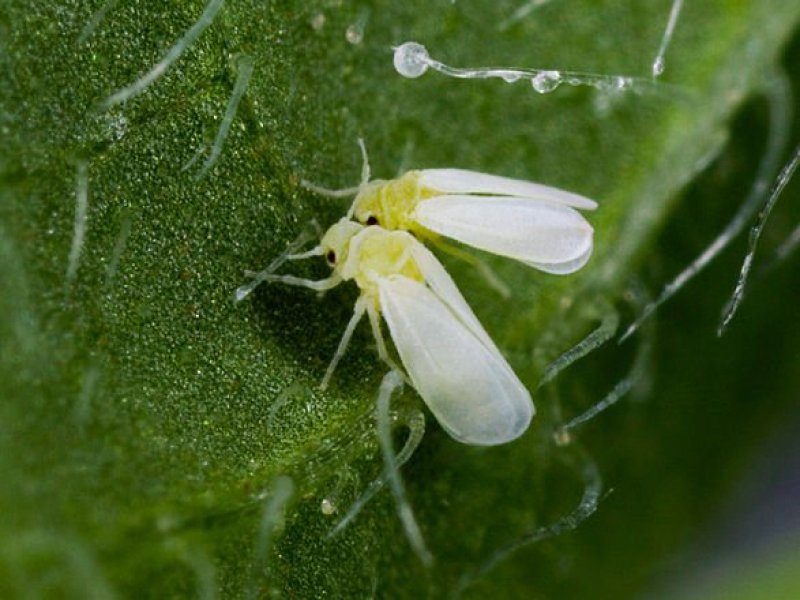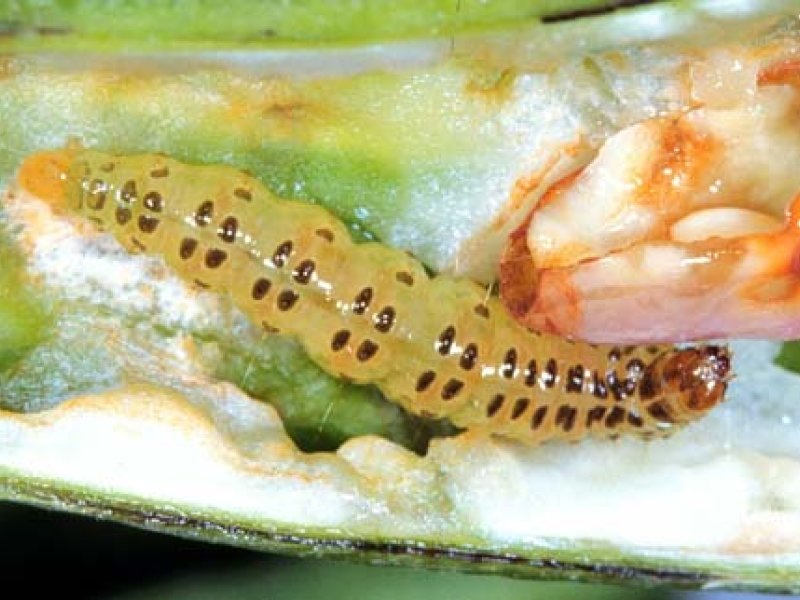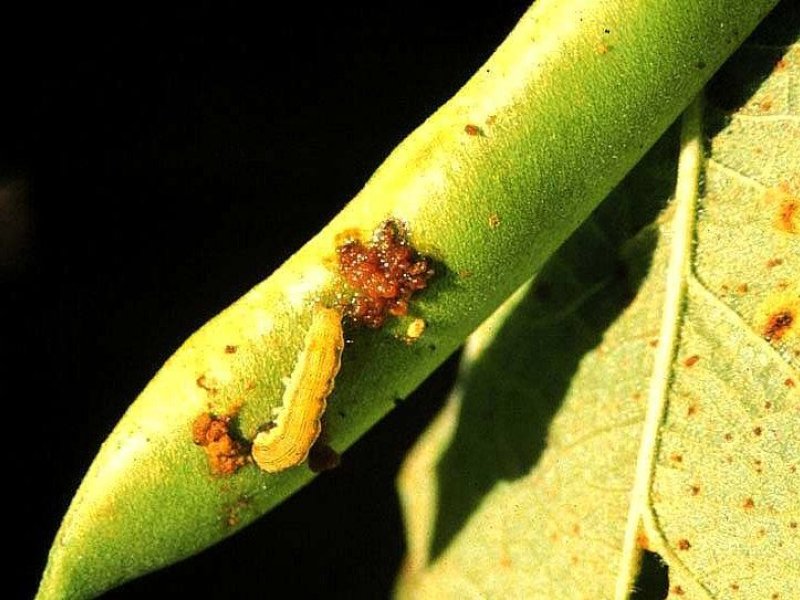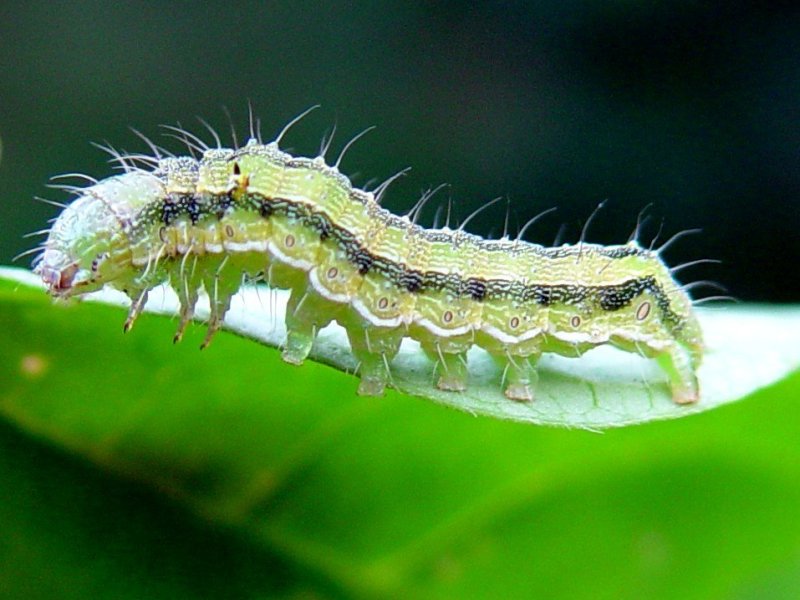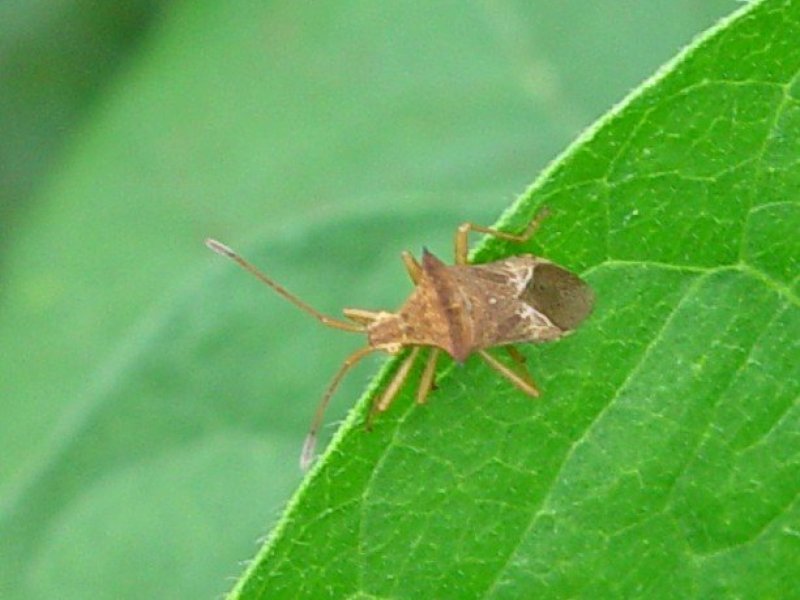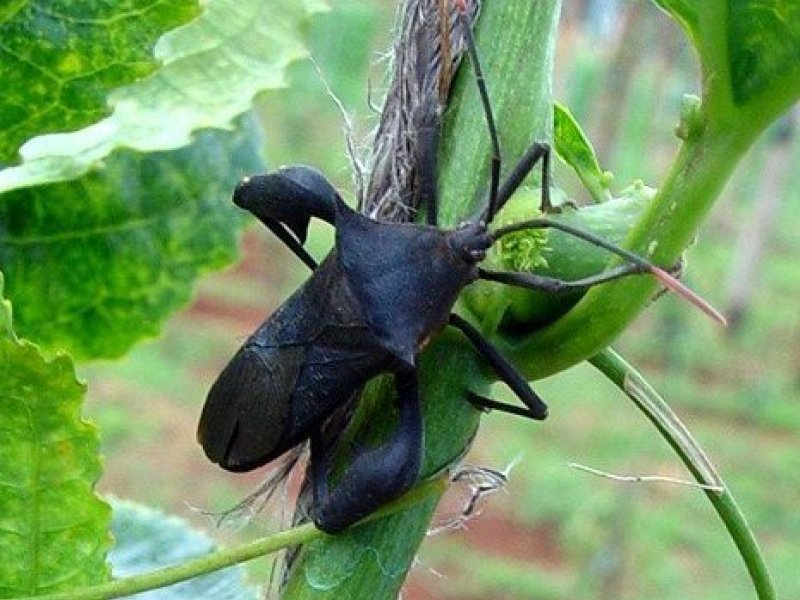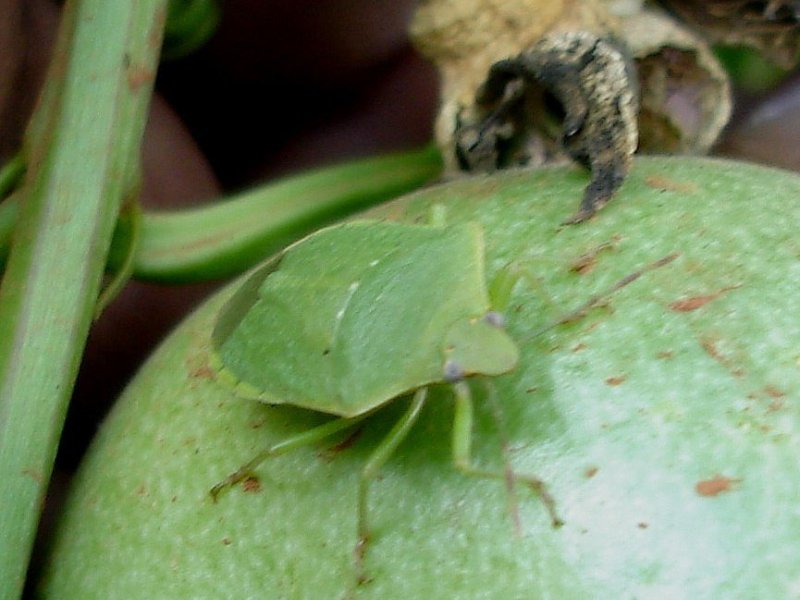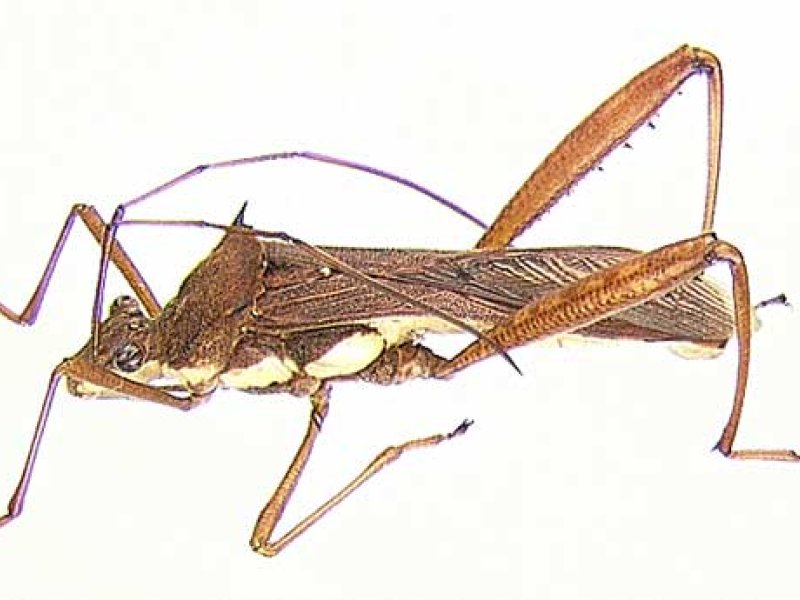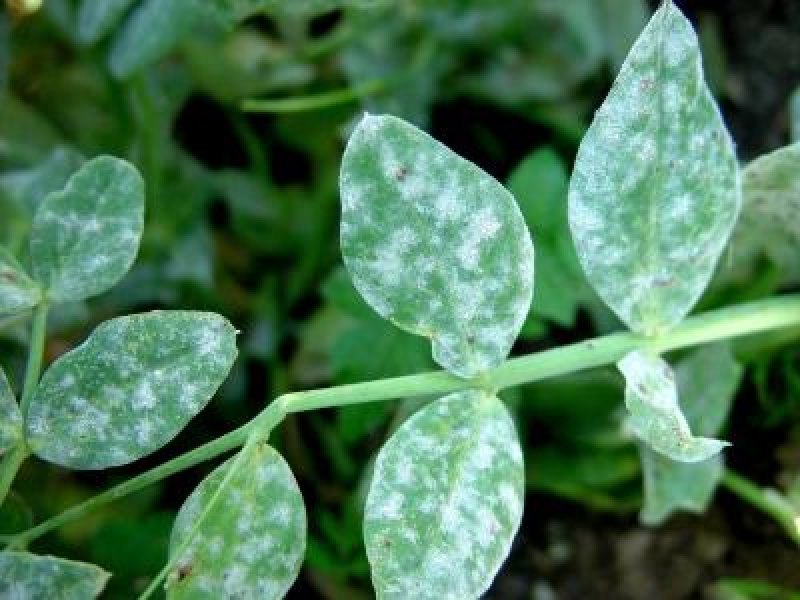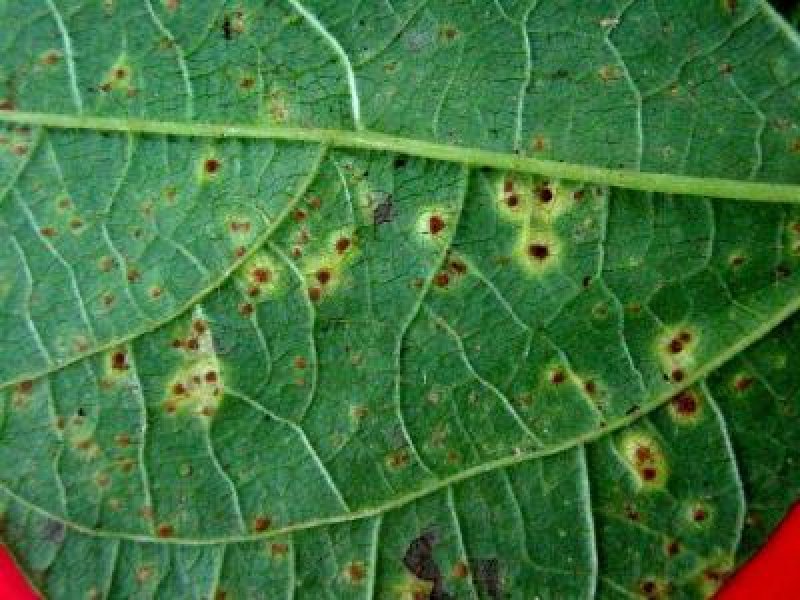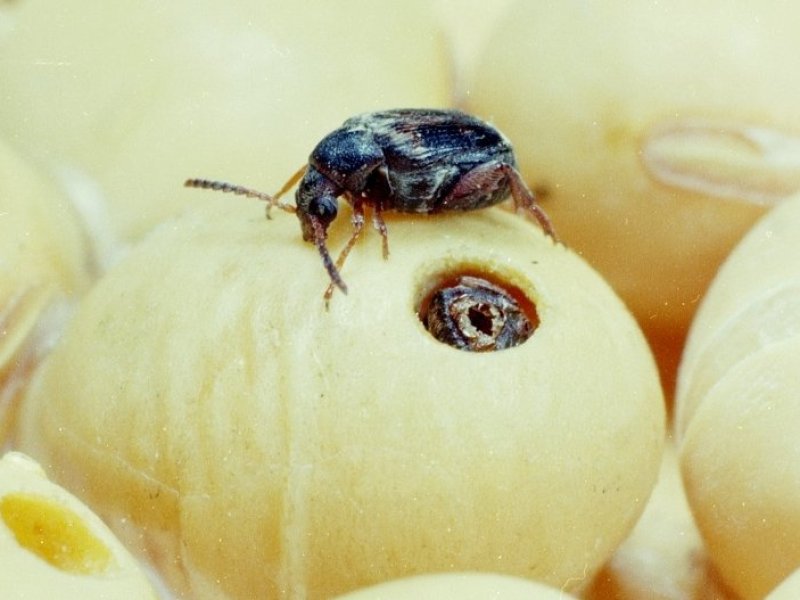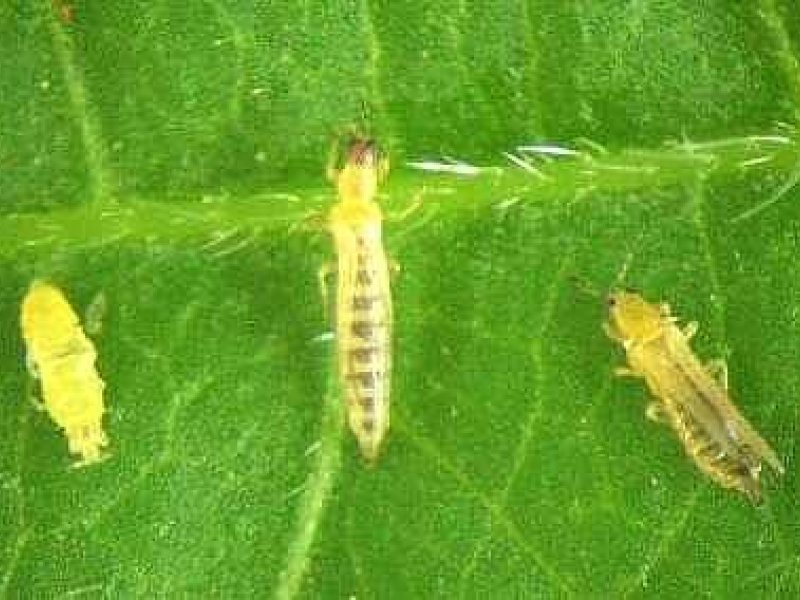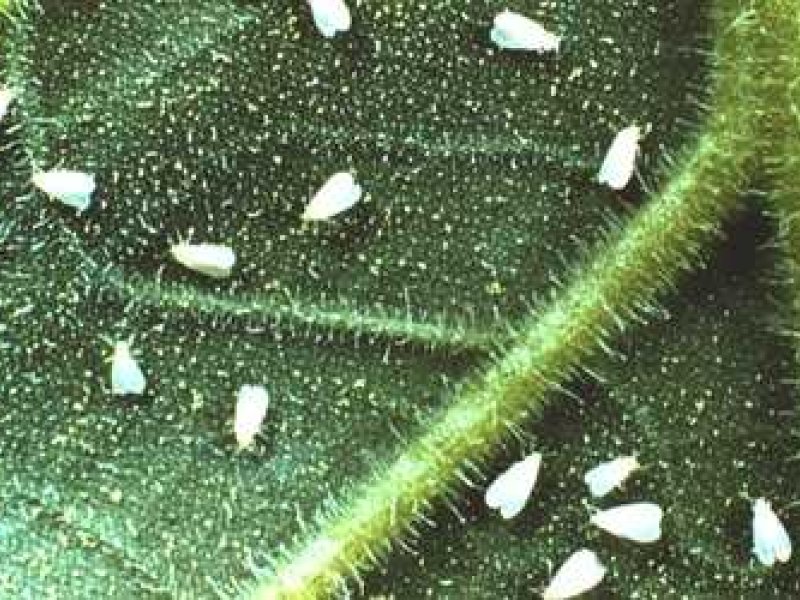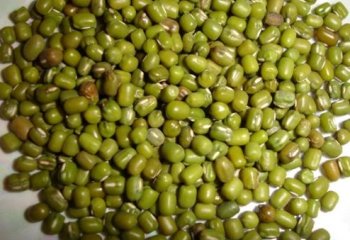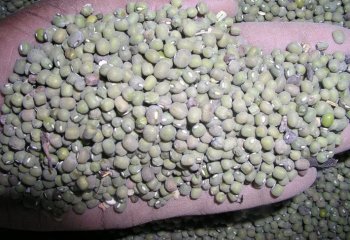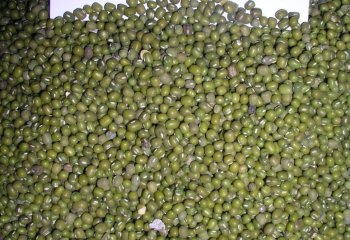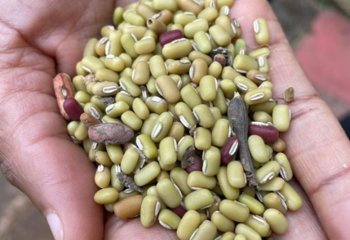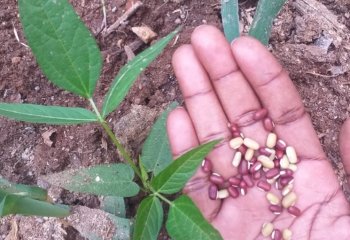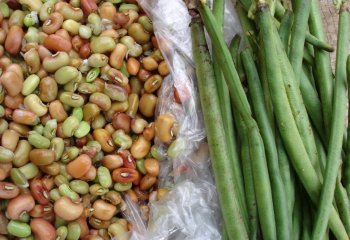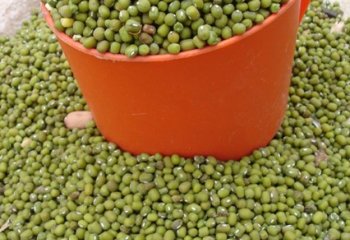|
Anthracnose (Colletotrichum lindemuthanium) It attacks all above ground parts of the plant. It does most serious damage on pods. Affected pods have brownish sunken spots, which under humid conditions are covered with a pink spore mass. Infected seeds become discoloured (brownish black).
|
|
|
What to do:
|
|
Aphids Aphids, mainly the legume aphid (Aphis craccivora) (also called groundnut aphid) are relative small. Immatures are slightly dusted with wax, adults without wax. Apterae are 1.4 to 2.2 mm long. Alatae (winged form) 1.4 to 2.1 mm. They feed on young plants, leaflets, stem and pods of green gram. Attacked young leaves become twisted. Excretion of honeydew leads to growth of sooty mould. Aphids are also vectors of virus diseases.
|
|
|
What to do:
|
|
Bacterial blight (bean blight) (Xanthomonas pv. phaseoli) Leaf spots first appear as small, water-soaked or light-green areas on leaflets. They later become dry and brown. The spots may join to affect much of leaf surface eventually killing the leaflet. Similar water-soaked spots develop on pods. The spot margin is a shade of red. Severely diseased pods shrivel. In humid weather, a yellowish crust of the blight bacteria covers the spot surface.
|
|
|
What to do:
|
|
Bean flies (Ophiomyia phaseoli and related species) Bean flies are tiny about 2 mm long, shiny black-bluish in colour. They can cause serious stand reductions at the seedling stage. Bean flies lay eggs in punctures of leaves near the petiole. The small white maggots feed inside the main stem just above the soil line. Pupation occurs inside the stem. The life cycle may be completed rapidly, often in less than 2 weeks. Seedlings attacked by bean flies may wilt or die. Leaves of older plants may be yellow and stunted. Stems are thicker than normal and cracked lengthwise just above the soil. Maggot feeding facilitates the entry of disease-causing microorganisms leading to secondary infections. In cases of heavy infestation, many plants die. Bean flies are important only during the seedling stage (up to 4 weeks after germination).
|
|
|
What to do:
|
|
Cowpea weevil (Callosobruchus maculatus) Cowpea bruchids (Callosobruchus spp.) are the most common and widespread insect pests in storage. Adults are 2 to 3.5 mm long. They are major pests of pulses (cowpeas, pigeon peas, soybean, green gram and lentils). They attack both pods in the field and seeds in storage. They attack nearly mature and dry pods. Infested stored seeds can be recognised by the round exit holes and the white eggs on the seed surface. Post-harvest losses are highly variable, but losses can be over 90%. It is a serious storage insect, which can destroy whole seed-lots. |
|
|
What to do:
|
|
Damping-off diseases (Pythium spp., Fusarium spp., Rhizoctonia solani) They are caused by a complex of fungi. They cause rotting of seeds before emergence and seedlings after emergence from the soil. Affected fields appear patchy. They are favoured by wet, cool weather.
|
|
|
What to do:
|
|
Foliage beetles (Ootheca spp.) Foliage beetles have been reported as pests of green grams in West Africa. They are a threat, when present in large numbers since they can defoliate young plants. They are 4-7mm long.
|
|
|
What to do:
|
|
Mungbean yellow mosaic virus (MYMV) MYMV causes serious loss in pulse crops such as beans, pigeonpea, mungbean and soybean. It is transmitted by whiteflies (Bemisia tabaci). Symptoms: initially mild scattered yellow spots appear on young leaves. The spots gradually increase in size and ultimately some leaves turn completely yellow. Infected leaves also show necrotic symptoms. Diseased plants are stunted, mature late and produce very few flowers and pods. Pods of infected plants are reduced in size and turn yellow in colour. The virus is not seed transmitted in mungbean or soybean. |
|
|
What to do:
|
|
Pod borers (African bollworm, Legume pod-borer, lima pod borer) Pod borers such as the African bollworm (Helicoverpa armiguera), the legume pod borer (Maruca vitrata), and the lima bean pod borer (Etiella zinckenella) can cause serious economic damage. Young caterpillars of the African bollworm feed on leaves by scraping tissue for short time, and then bore into the pods and feed on the seeds with their heads thrust inside and most part of the body outside. The entry hole is large and circular. They also cause significant damage to flower buds and flowers. Caterpillars of the legume pod borer (Maruca vitrata) are dull to yellow-white and often reach a length of 18 mm. Each segment has dark spots that form a distinct series along the length of the body. The head is dark brown to black. Caterpillars web together leaves, buds and pods and feed inside the web. Flowers attacked may be discoloured and have damaged or missing reproductive parts. Damage by this caterpillar also results in flower bud shedding and reduced pod production. Damaged pods have small, darkened entry holes on the surface. Young caterpillars of the lima bean pod borer are green, later turning red. They feed inside the pod reaching a length of 14 mm. They are generally found in maturing and dried pods. Faeces in the form of granules are found inside the damaging pods. Once the caterpillars have entered the pods they are difficult to control and by then they have already caused damage. |
|
|
What to do:
For more information on Neem click here. For information on Bt click here |
|
Pod sucking bugs Pod sucking bugs such as giant coreid bugs (Anoplocnemis curvipes), spiny brown bugs (Clavigralla spp.), green stink bugs (Nezara viridula, Acrosternum acutum), and Riptortus bugs (Riptortus spp) are the most important pests of green gram at the podding stage. They suck sap from pods and seeds and cause various levels of damage depending on the stage of growth of seeds at the time of attack. Feeding may cause necrosis, pod malformation, premature drying, shrivelling of seeds, loss of germination ability, and formation of empty pods. Bugs are difficult to control since they usually feed on a wide range of crops and are very mobile.
|
|
|
What to do:
|
|
Powdery mildew (Erysiphe polygoni) White powdery patches appear on leaves and other green parts, which later become dull coloured. These patches gradually increase in size and become circular covering the lower surface. When the infection is severe, both the surfaces of the leaves are completely covered by whitish powdery growth. Severely affected parts get shrivelled and distorted. In severe infections, foliage becomes yellow causing premature defoliation. The disease also creates forced maturity of the infected plants which results in heavy yield losses. The fungal agent (pathogen) has a wide host range and survives on various hosts in off-season. It is spread by wind and water splash.
|
|
|
What to do:
|
|
Rust (Uromyces phaseoli) The disease appears as circular reddish brown pustules (blisters) which appear more commonly on the underside of the leaves, less abundant on pods and sparingly on stems. When leaves are severely infected, both the surfaces are fully covered by rust pustules. Shrivelling of pods is followed by defoliation resulting in yield losses. Long distance spread of rust is by wind. Plant to plant spread is by farm tools, and moving bodies within the crop.
|
|
|
What to do:
|
|
Storage pests The pod weevil (Piezotrachelus varius or Apion varium). Its a common pest of cowpeas in West Africa. Generally 13-26% of the pods are damaged. Losses of seeds up to 92% have been reported in Nigeria. The shiny black weevils bore holes in fresh green cowpea pods and lay eggs into the pods. The grubs feed on the seeds and pupate within the pods.
|
|
|
What to do:
|
|
Flower thrips (Megalurothrips sjostedti) It may feed on petioles and leaves, but prefer flowers. Attacked petioles and leaves have tiny holes surrounded by discoloured areas. Affected flowers are brown, dried, or completely distorted. The flowers drop prematurely. Thrips also feed on pollen leading to decrease in pollination and seed set. Pod production is low and pods are deformed.
|
|
|
What to do:
|
|
Whiteflies (Bemisia tabaci, Aleurodicus dispersus) Several species of whiteflies are found on cassava in Africa. Feeding causes direct damage, which may cause considerable reduction in root yield if prolonged feeding occurs. Some whiteflies cause major damage to cassava as vectors of cassava viruses. The spiralling whitefly (Aleurodicus dispersus) was reported as a new pest of cassava in West Africa in the early 90s. The adults and nymphs of this whitefly occur in large numbers on the lower surfaces of leaves covered with large amount of white waxy material. Females lay eggs on the lower leaf surface in spiral patterns (like fingerprints) of white material secreted by the female. This whitefly sucks sap from cassava leaves. It excretes large amounts of honeydew, which supports the growth of black sooty mould on the plant, causing premature fall of older leaves. The tobacco whitefly (Bemisia tabaci) transmits the African cassava mosaic virus, one of the most important factors limiting production in Africa. The adults and nymphs of the tobacco whitefly occur on the lower surface of young leaves. They are not covered with white material. The nymphs appear as pale yellow oval specks to the naked eye. |
|
|
What to do:
|
Geographical Distribution in Africa
Geographical Distribution of Green gram in Africa. Updated on 8 July 2019. Source PROTA
General Information and Agronomic Aspects
Introduction
Vigna radiata, commonly known as mung bean or green gram, belongs to the family Fabaceae and the genus Vigna. It is a member of the legume family and is closely related to other leguminous plants like beans, lentils, and peas. Genus Vigna consist of more than 100 species. The genus holds agricultural significance, comprising 10 domesticated species (Crops) such as: Cowpeas (Vigna unguiculata), Adzuki bean (Vigna angularis) and Vigna umbellata (Rice bean).
Ⓒ Courtesy EcoPort, Pankaj Oudhia
Vigna radiata is native to India, South East Asia and Australia but is now widespread throughout tropical Africa and Asia. The major Vigna producing countries are Asia, Australia, West Indies, South and North America, and tropical and subtropical Africa. V. radiata is a resilient warm-season crop with a short growth cycle. It thrives in tropical and subtropical regions with well-drained soil, ample sunlight, and a robust nature.
Green grams are primarily cultivated for their seeds that come in different colors: green, black, or yellow. The seeds are consumed in various forms, such as whole beans, split beans (dal), and ground into flour. Mature mung bean seeds are prepared by cooking or milling. In Kenya, mung beans are typically eaten as whole seeds, boiled together with cereals like maize or sorghum. The seeds or the flour may be used in a variety of dishes like soups, porridge, snacks, bread, noodles and even ice cream. Immature pods and young leaves are also eaten as a vegetable. Green gram also produces sprouts, commonly used in salads and stir-fries. Mung beans are rich in protein, dietary fiber, vitamins (B vitamins, vitamin C), and minerals (iron, potassium, magnesium). Additionally, they are low in fat and contain antioxidants, making them a healthy choice for a balanced diet.
Crop residues of V. radiata are a useful fodder for livestock. Green gram is sometimes specifically grown for hay, green manure or as a cover crop. As green manure, they enrich the soil with nitrogen during fallow periods, reducing the need for artificial fertilizers. The plant requires less water and have a short growth cycle, making them suitable for regions with water scarcity or limited growing seasons. This aids in promoting biodiversity and sustainable farming practices.
In the global market, mung beans are produced by several key countries. In Asia, India, China, and Southeast Asian nations are significant producers and exporters. In Africa, countries like Nigeria, Sudan, and Uganda also contribute to the production of mung beans.
(Mogotsi, K.K., 2006. Heuzé V., et al., 2015, Healthline (n.d))
Species accounts
Mung bean (Vigna radiata) is an annual, erect to semi-erect, slightly pubescent herb that typically grows to a height of about 60 to 120 cm. Leaves: are trifoliate, which means each leaf is divided into three leaflets. The leaflets are smooth-edged and have a slightly heart-shaped appearance. Flowers: small and usually yellow, though some varieties may exhibit white or purple hues. They are arranged in clusters at the tips of the branches. Pods: are long, cylindrical, hairy and pending. They contain 7 to 20 small, ellipsoid or cube-shaped seeds. Seeds: variable in color: usually green, but can also be yellow, olive, brown, purplish brown or black, mottled and/or ridged. Seed colors and presence or absence of a rough layer are used to distinguish different types of mung bean
As the plant matures, it produces elongated pods that contain small, green, and bean-like seeds, which are the mung beans. These seeds are commonly used in various cuisines for their nutritional value and mild flavor. (Mogotsi, K.K., 2006, Heuzé V.et al., 2015)
Ⓒ Food of Nairobi people, 2005
Ⓒ Foods of Nairobi people, 2005
Green gram (mung beans) varieties
Green grams usually mature in 60 to 90 days. The early maturing varieties can often produce before drought destroys many bean species. Two varieties can be distinguished in Kenya:
| Variety | Maturity Days | Potential yield t/ha | Remarks |
| "KVR 22" ("N 22") | 80-90 | 1.0-1.3 |
|
| "KVR 26" (N 26) | 60-65 | 0.3-1.5 |
|
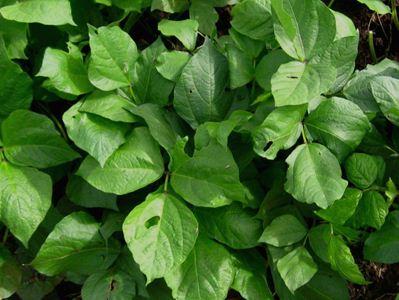 |
| Mungbean plant |
|
© A.A.Seif, icipe
|
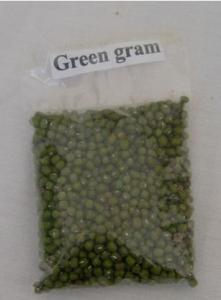 |
| Green gram seeds |
|
© A.A.Seif, icipe
|
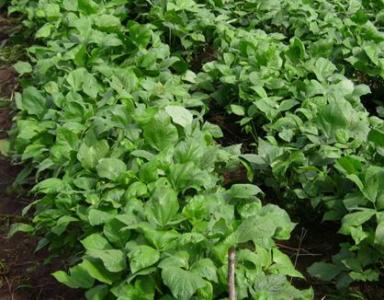 |
| Mungbean crop |
|
© A.A.Seif, icipe |
Examples of green grams varieties grown in Tanzania
- "Nuru" (performs well between 0 and 1350 m above sea level; days to flowering: 50; yield potential: 1.5 t/ha; resistant to mosaic disease; moderately resistant to bacterial blight)
- "Imara" (grows well between 0 and 1350 m above sea level; days to flowering: 50; yield potential: 1.5 t/ha; resistant to mosaic disease; moderately resistant to bacterial blight; it has wide adaptability)
Examples of green gram varieties grown in Uganda
- "N 26" (characteristics as in Kenya)
- "N 22" (characteristics as in Kenya)
Related species
Rice bean (Vigna umbellata)
Commonly known as the rice bean is native to Asian continent, where it is found wild from India and central China through Indo-China to Malaysia. Today, rice bean is extensively cultivated in tropical Asia and to a lesser extent in Fiji, the US, Australia, southwestern Asia, and tropical Africa and America. In Africa, it's cultivated mainly in West and East Africa, Indian Ocean islands, and occasionally in Central and Southern Africa.
V. umbellata is a short-lived perennial legume usually grown as an annual crop. It displays varying growth habits—erect, semi-erect, or twining—and usually reaches 30-100 cm in height, sometimes up to 200 cm. It has an extensive root system with a taproot that can go as deep as 100-150 cm. The stems are branched and finely haired. Leaves: are trifoliate with entire, 6-9 cm long leaflets. Flowers: born on 5-10 cm long axillary racemes, are papillonaceous and bright yellow. Fruits: cylindrical, 7.5-12.5 cm long pods that contain 6-10 oblong, 6-8 mm seeds with a concave hilum. Seeds: variable in colour, from greenish-yellow to black through yellow, brown. Yellow-brownish types are reported to be the most nutritious.
Rice beans thrive in tropical climates. They have adapted well to the warm and humid conditions of tropical Asia, where they are extensively cultivated. The legumes are valuable source of nutrition, offering protein and other essential nutrients. The dry seeds can be boiled and eaten with rice or used as a rice substitute in dishes like stews and soups. In Madagascar, the seeds are ground to make nutritious flour for children's food. The young pods, leaves, and sprouted seeds are boiled and enjoyed as vegetables, and the young pods are occasionally consumed raw (Heuzé V et al., 2016).
|
|
© Maundu P, 2022 |
Cowpeas (Vigna unguiculata)
Is one of the most popular grain legumes in Africa as well as in some regions of America and Asia. The native range of this species is Cape Verde, Tropical & S. Africa. Its cultivation dates back thousands of years, making it one of the oldest domesticated crops. From its African origins, cowpea spread to other parts of the world through trade and migration. It is now grown in tropical and subtropical regions across Africa, Asia, the Americas, and even in some parts of Europe.
Cowpea is an erect, trailing, or climbing annual or perennial herb. Leaves: trifoliate and alternately arranged on the stem. Flowers: vary in color from pale green to light blue or purple, sometimes white or yellowish and produce distinctive bean pods. Pods: long, nearly cylindrical pod can range between 8 and 120 cm in length and may be straight or slightly curved, cream to brown or reddish purple when dry and 8-30-seeded. Seeds: can be mottled or varying uniform colors ranging from white or cream to maroon or brown to black. The seeds of popular cowpea varieties, such as "black-eyed pea" and "pinkeye purple hull" typically have a white color with a circular, asymmetrical black or red pigmented region surrounding the hilum that gives the seeds the appearance of an eye.
Cowpea is primarily cultivated for its edible seeds, which are consumed in various forms. The young pods, leaves, and immature seeds are often used as vegetables in traditional cuisines. The mature seeds are commonly used in stews, soups, curries, and side dishes. They are a staple food in many regions, providing a valuable source of protein, carbohydrates, and dietary fiber. Cowpea is also used in fodder production for livestock and has potential as a cover crop due to its ability to fix nitrogen in the soil.
Cowpea seeds are significant sources of plant based proteins, especially in areas where animal protein is limited. They also contain complex carbohydrates, dietary fiber, vitamins (such as folate and vitamin B), and minerals (including iron, calcium, and potassium). Additionally, cowpea seeds are relatively low in fat and are a good source of antioxidants.
(Kew botanical gardens, Madamba et al., 2006, AVRDC & IPGRI, 2006, Timko & Singh, 2008, Schippers, 2000).
Ⓒ Maundu P, 2005
Hairy cowpeas (Vigna membranacea)
Tthe native range of this species is Eritrea to Tanzania, SW. Arabian Peninsula.
V. membranacea is a climbing or trailing annual plant. Leaves: pinnate leaves with multiple leaflets, each leaflet usually with side lobes. Flowers: Blue, tinged purple. Fruit: A narrow pod.
The seeds, tender leaves and flowes are used as vegetable in various part of Africa. In Kenya the leaves are fried and eaten with ugali. Said to taste like cowpea leaves (Kitui and Mwingi). Also boiled and mashed with maize and beans. The seeds are also boiled and used to prepare soups and curries as well. Beyond their culinary use, hairy cowpeas are also cultivated as cover crops and green manure due to their ability to enrich soil fertility.
Hairy Cowpea is a rich source of plant-based protein, making them an important protein alternative, especially for vegetarian and vegan diets. They also contain various vitamins, including vitamin B6 and folic acid, and minerals like iron, magnesium, and potassium.
(Kew botanical gardens, Maundu, P et al.,1999).
Adzuki bean (Vigna angularis)
The species is native to East Asia, particularly China and Japan, Korea, and India. It is now widely grown in moister tropical and subtropical areas around the world. They are well-suited to warm temperate and subtropical climates. Adzuki beans thrive in well-drained soils and are often cultivated in rotation with other crops to improve soil fertility. They can also tolerate moderate drought conditions, making them adaptable to various ecological niches. Adzuki beans typically grow to about 30-60 cm in height. Leaves: are trifoliate, with ovate leaflets that have serrated edges. Flowers: are small and usually a shade of pink or purplish-red, arranged in clusters on long stalks. Seeds: small, approximately 3-5 mm in length, and are kidney-shaped with a distinct ridge on one side.
V. angularis dried seeds are consumed by cooking them whole or processing them into flour. They're utilized in various dishes like soups, cakes, confectionery, and ice cream. Tender young pods are cooked as a vegetable. The immature and sprouted seeds are eaten as a vegetable. They can be popped like corn, used as a coffee alternative, or enjoyed candied. Adzuki beans also grown for forage, green manure, and soil conservation. The flour finds use in shampoos, facial creams, and culture media. In China, the beans are used medicinally for kidney issues, constipation, abscesses, certain tumors, and more. They're believed to enhance blood circulation and urination. The leaves are thought to reduce fever, while the sprouts can prevent injury-induced threatened abortion.
Adzuki beans are rich in complex carbohydrates, dietary fiber, and plant-based protein. They also contain essential nutrients such as folate, potassium, magnesium, and B vitamins. Adzuki beans are particularly known for their high antioxidant content, which contributes to their potential health benefits. Apart from their culinary and potential medicinal uses, adzuki beans have been used as livestock feed due to their nutritional value. Adzuki bean plants can also be used as green manure, enriching the soil with nitrogen when incorporated into the earth.
(Jansen, 2006, pfaf.org, n,d))
Ecological conditions
Green grams grow best at an altitude of 0-1600 m above sea level and under warm climatic conditions (28 to 30degC). They are well adapted to red sandy loam soils, but also do reasonably well on not too exhausted sandy soils. Green grams are not tolerant to wet, poorly drained soils. They are drought tolerant and will give reasonable yields with as little as 650 mm of yearly rainfall. Heavy rainfall results in increased vegetative growth with reduced pod setting and development.
Agronomic aspects
Avoid planting green gram for more than one season because toxic residues and disease organisms from the previous green gram crop may affect the following crop adversely.
Land should be prepared to a medium tilth before planting and early enough so that planting can start immediately after the rain starts. When using oxen plough for planting, place the seed at the side of the furrow.
Propagation is by seed. There is no seed dormancy. Seeds may sprout in the pod under very humid conditions. In areas with higher rainfall, it is recommended to grow green grams on raised beds. Prepare the beds, raised about 20 cm and spaced 1 m from the centre of one bed to the centre of the next. Sow seeds on raised beds in two rows per bed, spaced 45 cm apart.
Green grams will respond to fertiliser or manure application but will normally give satisfactory results if grown on relatively good soil. Green gram is grown mainly on smallholdings, often as mixed crops or intercrops. Associated crops are usually of longer duration than green gram (sugar-cane, cotton, sorghum). To make use of a short cropping period, short-duration green gram is often relay-cropped.
Husbandry
With the newer cultivars ripening in 60 to 75 days, maximum yields are obtained at plant densities of 300 to 400,000 plants per ha. The later-maturing traditional cultivars generally need wider spacing. Usually no fertilisers are applied to green gram. Over the centuries, green grams adaptation to stable performance in marginal environments has resulted in a low yield potential, which limits responsiveness to better environments and improved cultural practices. However, if planted in heavily eroded soil gram will benefit from any kind of manure or compost.
Grams planted at the end of the long rains are normally intercropped into other major crop. In Meru, Kenya, green gram is a preferred intercrop for millet, each said to protect the other against diseases and pests. If grams are intercropped with maize, the maize spacing is the same as in pure stand, but the grams are interplanted mid-way between the maize rows. Early weeding is recommended. First weeding should be done just after emergence and second weeding just before flowering.
Harvest, post-harvest practices and markets
Harvesting
Harvesting is generally by two to five hand-pickings at weekly intervals and is the most expensive single operation in growing green gram. Short-duration cultivars, which ripen more uniformly, may be processed as whole plants on small rice threshers. Cultivars differ markedly in harvesting efficiency, depending on position (above or within canopy) and size of pods. Harvesting before the maturity of crop, usually result in lower yields, higher proportion of immature seeds, poor grain quality and more chances of infestation during storage. Delay in harvesting results in shattering of pods and other losses caused by pests.
In Kenya, harvesting when 95% of pods have turned black is recommended. The whole plant can then be uprooted and dried for about 2 days, then threshed and winnowed. Harvesting during adverse weather condition i.e. rains and overcast weather should be avoided. Such weather is conducive to fungal infection. The harvested bundles should be kept in one direction in order to ascertain efficient threshing. They should be stacked in a dry, clean place in cubical way to facilitate circulation of the air around.
Post-harvest practices.
Storage
Grams must be dry before storage. Like most pulses moisture content at storage should not be above 13%. Grams are very susceptible to bruchid (bean weevil) attack and are best stored immediately after sun drying either in airtight drums tins, gunny bags and be kept in a clean, ventilated place. Mixing seed with ash is effective against bruchids, also treatment with sunflower oil or mixing with neem leaves is said to be effective against storage pests. Proper drying of grains is very important to prevent the growth of fungi and contamination with aflatoxins. Infected grains should be separated from sound grains to avoid aflatoxin contamination.
Markets
At present, there is a rise in the demand for mung beans due to the growing vegan populace, coupled with the increasing consumer preference for organic and nutritious food products. The leading producers of the crops include; India, China, Thailand, Myanmar, and Pakistan. In Africa, Sudan, Uganda, and Ethiopia have emerged as significant producers. The marketing of mung beans takes various forms, including the raw legumes (dried or fresh form) for cooking and sprouting, as well as processed products like flour and noodles. These products are accessible through local markets, supermarkets, and online platforms, catering to diverse consumer preferences worldwide. (Mogotsi, K.K., 2006, Expertmarketresearch.com).
© Maundu, 2005
Nutritional value and recipes
Mung bean is a nutrient-rich legume that offers a range of health benefits. The tiny green legumes are a source of plant-based protein, making them a great option for vegetarians and vegans.
Mung beans are also rich in dietary fiber, aiding in digestion and promoting a healthy gut. Fiber helps regulate bowel movements and can contribute to a feeling of fullness, which might assist in weight management. Moreover, mung beans have a low glycemic index, meaning they release energy slowly, helping to control blood sugar levels.
They are particularly abundant in folate (vitamin B9), which is crucial for cell division and the formation of DNA. Additionally, mung beans contain significant amounts of manganese, magnesium, potassium, and phosphorus, all of which play roles in bone health, muscle function, and overall electrolyte balance.
These beans are also a source of antioxidants like Vitamin C and Vitamin E, which help protect cells from damage caused by harmful free radicals. Such antioxidants are beneficial for maintaining healthy skin, supporting the immune system, and reducing the risk of chronic diseases. Incorporating mung beans into your diet is relatively easy. They can be used in various dishes, including soups, stews, salads, and even sprouted for added crunch and nutrition. Their versatility and impressive nutritional profile make them a valuable ingredient for those seeking a healthful and well-rounded diet.
Further reading:
Healthline n.d- https://www.healthline.com/nutrition/mung-beans
Webmd- https://www.webmd.com/diet/health-benefits-bean-sprouts
Table 1: Proximate nutritional value of 100g of green gram stew.
|
Food Name |
Green Gram Stew |
Recommended daily allowance (approx.) for adults a |
|
Edible conversion factor |
||
|
Energy (kJ) |
454 |
9623 |
|
Energy (kcal) |
109 |
2300 |
|
Water (g) |
74.4 |
2000-3000c |
|
Protein (g) |
6.3 |
50 |
|
Fat (g) |
4.2 |
<30 (male), <20 (female)b |
|
Carbohydrate available (g) |
9.3 |
225 -325g |
|
Fibre (g) |
4 |
30d |
|
Ash (g) |
1.7 |
|
|
Minerals |
||
|
Ca (mg) |
33 |
800 |
|
Fe (mg) |
1.6 |
14 |
|
Mg (mg) |
43 |
300 |
|
P (mg) |
61 |
800 |
|
K (mg) |
184 |
4,700f |
|
Na (mg) |
243 |
<2300e |
|
Zn (mg) |
0.57 |
15 |
|
Se (mcg) |
5 |
30 |
|
Bioctive compounds. |
||
|
Vit A RAE (mcg) |
4 |
800 |
|
Vit A RE (mcg) |
8 |
800 |
|
Retinol (mcg) |
0 |
1000 |
|
b-carotene equivalent (mcg) |
46 |
600 – 1500g |
|
Thiamin (mg) |
0.08 |
1.4 |
|
Riboflavin (mg) |
0.04 |
1.6 |
|
Niacin (mg) |
0.4 |
18 |
|
Dietary Folate Eq. (mcg) |
71 |
400f |
|
Food folate (mcg) |
71 |
400f |
|
Vit B12 (mg) |
0 |
3 |
|
Vit C (mg) |
2.1 |
60 |
Source (Nutrient data): FAO/Government of Kenya. 2018. Kenya Food Composition Tables. Nairobi, 254 pp. http://www.fao.org/3/I9120EN/i9120en.pdf
RE=retinol equivalents.
RAE =Retinol activity equivalents. A RAE is defined as 1μg all-trans-retinol, 12μg beta-carotene, or 24μg α-carotene or β-cryptoxanthin.
a Lewis, J. 2019. Codex nutrient reference values. Rome. FAO and WHO
b NHS (refers to saturated fat)
c https://www.hsph.harvard.edu/nutritionsource/water/
d British Heart Foundation
e FDA
f NIH
g Mayo Clinic
Information on Pests
| Bean flies (Ophiomyia phaseoli and related species) Bean flies are tiny about 2 mm long, shiny black-bluish in colour. They can cause serious stand reductions at the seedling stage. Bean flies lay eggs in punctures of leaves near the petiole. The small white maggots feed inside the main stem just above the soil line. Pupation occurs inside the stem. The life cycle may be completed rapidly, often in less than 2 weeks. Seedlings attacked by bean flies may wilt or die. Leaves of older plants may be yellow and stunted. Stems are thicker than normal and cracked lengthwise just above the soil. Maggot feeding facilitates the entry of disease-causing microorganisms leading to secondary infections. In cases of heavy infestation, many plants die. Bean flies are important only during the seedling stage (up to 4 weeks after germination).
What to do:
|
| Whiteflies (Bemisia tabaci, Aleurodicus dispersus) Several species of whiteflies are found on cassava in Africa. Feeding causes direct damage, which may cause considerable reduction in root yield if prolonged feeding occurs. Some whiteflies cause major damage to cassava as vectors of cassava viruses. The spiralling whitefly (Aleurodicus dispersus) was reported as a new pest of cassava in West Africa in the early 90s. The adults and nymphs of this whitefly occur in large numbers on the lower surfaces of leaves covered with large amount of white waxy material. Females lay eggs on the lower leaf surface in spiral patterns (like fingerprints) of white material secreted by the female. This whitefly sucks sap from cassava leaves. It excretes large amounts of honeydew, which supports the growth of black sooty mould on the plant, causing premature fall of older leaves. The tobacco whitefly (Bemisia tabaci) transmits the African cassava mosaic virus, one of the most important factors limiting production in Africa. The adults and nymphs of the tobacco whitefly occur on the lower surface of young leaves. They are not covered with white material. The nymphs appear as pale yellow oval specks to the naked eye. What to do:
|
| Aphids, mainly the legume aphid (Aphis craccivora) (also called groundnut aphid) are relative small. Immatures are slightly dusted with wax, adults without wax. Apterae are 1.4 to 2.2 mm long. Alatae (winged form) 1.4 to 2.1 mm. They feed on young plants, leaflets, stem and pods of green gram. Attacked young leaves become twisted. Excretion of honeydew leads to growth of sooty mould. Aphids are also vectors of virus diseases.
What to do:
|
| Foliage beetles (Ootheca spp.) Foliage beetles have been reported as pests of green grams in West Africa. They are a threat, when present in large numbers since they can defoliate young plants. They are 4-7mm long.
What to do:
|
| Pod borers (African bollworm, Legume pod-borer, lima pod borer) Pod borers such as the African bollworm (Helicoverpa armiguera), the legume pod borer (Maruca vitrata), and the lima bean pod borer (Etiella zinckenella) can cause serious economic damage. Young caterpillars of the African bollworm feed on leaves by scraping tissue for short time, and then bore into the pods and feed on the seeds with their heads thrust inside and most part of the body outside. The entry hole is large and circular. They also cause significant damage to flower buds and flowers. Caterpillars of the legume pod borer (Maruca vitrata) are dull to yellow-white and often reach a length of 18 mm. Each segment has dark spots that form a distinct series along the length of the body. The head is dark brown to black. Caterpillars web together leaves, buds and pods and feed inside the web. Flowers attacked may be discoloured and have damaged or missing reproductive parts. Damage by this caterpillar also results in flower bud shedding and reduced pod production. Damaged pods have small, darkened entry holes on the surface. Young caterpillars of the lima bean pod borer are green, later turning red. They feed inside the pod reaching a length of 14 mm. They are generally found in maturing and dried pods. Faeces in the form of granules are found inside the damaging pods. Once the caterpillars have entered the pods they are difficult to control and by then they have already caused damage. What to do:
For more information on Neem click here. For information on Bt click here |
| Pod sucking bugs such as giant coreid bugs (Anoplocnemis curvipes), spiny brown bugs (Clavigralla spp.), green stink bugs (Nezara viridula, Acrosternum acutum), and Riptortus bugs (Riptortus spp) are the most important pests of green gram at the podding stage. They suck sap from pods and seeds and cause various levels of damage depending on the stage of growth of seeds at the time of attack. Feeding may cause necrosis, pod malformation, premature drying, shrivelling of seeds, loss of germination ability, and formation of empty pods. Bugs are difficult to control since they usually feed on a wide range of crops and are very mobile.
What to do:
|
| Flower thrips (Megalurothrips sjostedti) It may feed on petioles and leaves, but prefer flowers. Attacked petioles and leaves have tiny holes surrounded by discoloured areas. Affected flowers are brown, dried, or completely distorted. The flowers drop prematurely. Thrips also feed on pollen leading to decrease in pollination and seed set. Pod production is low and pods are deformed.
What to do:
|
| Cowpea weevil (Callosobruchus maculatus) Cowpea bruchids (Callosobruchus spp.) are the most common and widespread insect pests in storage. Adults are 2 to 3.5 mm long. They are major pests of pulses (cowpeas, pigeon peas, soybean, green gram and lentils). They attack both pods in the field and seeds in storage. They attack nearly mature and dry pods. Infested stored seeds can be recognised by the round exit holes and the white eggs on the seed surface. Post-harvest losses are highly variable, but losses can be over 90%. It is a serious storage insect, which can destroy whole seed-lots. What to do:
|
| The pod weevil (Piezotrachelus varius or Apion varium). Its a common pest of cowpeas in West Africa. Generally 13-26% of the pods are damaged. Losses of seeds up to 92% have been reported in Nigeria. The shiny black weevils bore holes in fresh green cowpea pods and lay eggs into the pods. The grubs feed on the seeds and pupate within the pods.
What to do:
|
Information on Diseases
| Bacterial blight (bean blight) (Xanthomonas pv. phaseoli) Leaf spots first appear as small, water-soaked or light-green areas on leaflets. They later become dry and brown. The spots may join to affect much of leaf surface eventually killing the leaflet. Similar water-soaked spots develop on pods. The spot margin is a shade of red. Severely diseased pods shrivel. In humid weather, a yellowish crust of the blight bacteria covers the spot surface.
What to do:
|
| Powdery mildew (Erysiphe polygoni) White powdery patches appear on leaves and other green parts, which later become dull coloured. These patches gradually increase in size and become circular covering the lower surface. When the infection is severe, both the surfaces of the leaves are completely covered by whitish powdery growth. Severely affected parts get shrivelled and distorted. In severe infections, foliage becomes yellow causing premature defoliation. The disease also creates forced maturity of the infected plants which results in heavy yield losses. The fungal agent (pathogen) has a wide host range and survives on various hosts in off-season. It is spread by wind and water splash.
What to do:
|
| The disease appears as circular reddish brown pustules (blisters) which appear more commonly on the underside of the leaves, less abundant on pods and sparingly on stems. When leaves are severely infected, both the surfaces are fully covered by rust pustules. Shrivelling of pods is followed by defoliation resulting in yield losses. Long distance spread of rust is by wind. Plant to plant spread is by farm tools, and moving bodies within the crop.
What to do:
|
| Damping-off diseases (Pythium spp., Fusarium spp., Rhizoctonia solani) They are caused by a complex of fungi. They cause rotting of seeds before emergence and seedlings after emergence from the soil. Affected fields appear patchy. They are favoured by wet, cool weather.
What to do:
|
| Anthracnose (Colletotrichum lindemuthanium) It attacks all above ground parts of the plant. It does most serious damage on pods. Affected pods have brownish sunken spots, which under humid conditions are covered with a pink spore mass. Infected seeds become discoloured (brownish black).
What to do:
|
| Mungbean yellow mosaic virus (MYMV) MYMV causes serious loss in pulse crops such as beans, pigeonpea, mungbean and soybean. It is transmitted by whiteflies (Bemisia tabaci). Symptoms: initially mild scattered yellow spots appear on young leaves. The spots gradually increase in size and ultimately some leaves turn completely yellow. Infected leaves also show necrotic symptoms. Diseased plants are stunted, mature late and produce very few flowers and pods. Pods of infected plants are reduced in size and turn yellow in colour. The virus is not seed transmitted in mungbean or soybean. What to do:
|
References and information links
References
1. AIC (2002). Field Crops Technical Handbook.
2. Adamu, R. S., Dike, M. C., Akpa, A. D. (2001). Insect fauna associated with green gram (Vigna radiata (L.) Wilc.) in the Northern Guinea Savanna of Nigeria. Journal of Sustainable Agriculture and the Environment, (Vol. 3) (No. 2) 331-336.
3. CAB International (2005). Crop Protection Compendium, 2005 edition. Wallingford, UK www.cabi.org
4. From ECHO's seedbank. Green Gram or Mung Bean (Vigna radiata). By Bob Hargrave, ECHO Staff. www.echonet.org Available here: download
5. Heuzé V., Tran G., Bastianelli D., Lebas F., 2015. Mung bean (Vigna radiata). Feedipedia, a programme by INRAE, CIRAD, AFZ and FAO. https://www.feedipedia.org/node/235 Last updated on July 3, 2015, 10:04
6. Insect Pest Management in Moong. Integrated Pest Management.
7. JNKVV, Madhya Pradesh, India: Diseases of green grams.
8. Kenya Agricultural Research Institute. KARI. Improved Green Gram Production. www.kalro.org
9. Mogotsi, K.K., 2006. Vigna radiata (L.) R.Wilczek. [Internet] Record from PROTA4U. Brink, M. & Belay, G. (Editors). PROTA (Plant Resources of Tropical Africa / Ressources végétales de l’Afrique tropicale), Wageningen, Netherlands. <http://www.prota4u.org/search.asp>. Accessed 18 December 2021.
10. National Research Council. 2006. Lost Crops of Africa: Volume II: Vegetables. Washington, DC: The National Academies Press. Available online: www.nap.edu
11. Nutrition Data www.nutritiondata.com.
12. Post harvest profile of green gram. Government of India, Ministry of Agriculture (Department of Agriculture and Cooperation) Directorate of Marketing and inspection. Branch Head Office. Nagpur - 440001. MRPC-76. www.agmarknet.nic.in
13. Publications and Fact Sheets on Mungbean. AVRDC Extension Materials. www.avrdc.org
14. Vigna radiata (L.) R.Wilczek in GBIF Secretariat (2021). GBIF Backbone Taxonomy. Checklist dataset https://doi.org/10.15468/39omei accessed via GBIF.org on 2021-12-18.
15. Heuzé V., Tran G., Boval M., 2016. Rice bean (Vigna umbellata). Feedipedia, a programme by INRAE, CIRAD, AFZ and FAO. https://www.feedipedia.org/node/234 Last updated on April 20, 2016, 17:00
16. Jansen, P.C.M., 2006. Vigna angularis (Willd.) Ohwi & H.Ohashi. In: Brink, M. & Belay, G. (Editors). PROTA (Plant Resources of Tropical Africa / Ressources végétales de l’Afrique tropicale), Wageningen, Netherlands. Accessed 12 August 2023.
17. Bosch, C.H., 2004. Vigna luteola (Jacq.) Benth. [Internet] Record from PROTA4U. Grubben, G.J.H. & Denton, O.A. (Editors). PROTA (Plant Resources of Tropical Africa / Ressources végétales de l’Afrique tropicale), Wageningen, Netherlands. <http://www.prota4u.org/search.asp>.
18. Waniale, A., Wanyera, N., & Talwana, H. (2014). Morphological and agronomic traits variations for mungbean variety selection and improvement in Uganda. African Crop Science Journal, 22(2), 123-136.
Information links
Contact links
1. Directory of 3,046 active & genuine Green mung beans manufacturers & exporters. https://www.volza.com/p/green-mung-beans/manufacturers/
2. Mung Bean Suppliers and Wholesale Distributors. https://www.targray.com/pulses/mung-bean
3. Directory of Green Mung Bean Importers. https://importer.tradeford.com/green-mung-bean
4. Green Mung Beans Suppliers and Manufacturers. https://www.go4worldbusiness.com/find?searchText=green-mung-beans&BuyersOrSuppliers=suppliers
5. Meru Herbs Organic Farmers Kenya
P.O. Box 14343-00800 Nairobi, Kenya
Tel/Fax: + 254 20 2673216, 0722 515 328
Email: nairobi@meruherbs.com
Products: Organic produced chamomile, hibiscus, and fruits (bananas & mango).
Review Process
Dr. Patrick Maundu, James Kioko, Charei Munene and Monique Hunziker, July 2024

